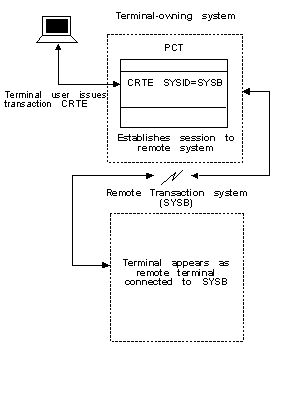Using the Routing Transaction CRTE
You can use the supplied transaction CRTE to start a routing session on a remote system. When the routing session has been established, your local system appears as a remote terminal to the remote system. All transactions invoked during this session are executed on the remote system.
The use of CRTE to implement transaction routing is illustrated below.

No configuration of the local or remote system (other than the link itself) is required when using CRTE. You should use CRTE, instead of making PCT definitions, in the following cases:
- For infrequently-invoked transactions.
- For transactions that reside on all of your systems.
Note that, because the routing session has to be explicitly established and canceled, you might have to perform additional signon operations.
If the user does not sign on, the surrogate terminal created is associated with the AOR default user. When a transaction is run, the security checks are carried out against this default user.
If the user does sign on, using the CESN transaction while running CRTE, the surrogate points to the userid of the signed-on user.
CRTE supports both conversational and pseudo-conversational transactions. Transactions invoked by PA or PF keys cannot be invoked through CRTE.